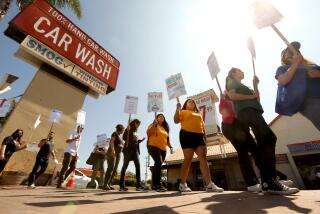This steel industry battle shows why unions are necessary
- Share via
As we approach Labor Day, the old question about what unions are good for is being played out in the steel industry, where Allegheny Technologies has locked out more than 2,000 workers in an effort to extract sizable concessions on health and retirement benefits from the United Steelworkers union.
Allegheny intends to replace those workers with non-union workers -- in common parlance, scabs -- who will be offered jobs for temporarily premium wages, no benefits, and a guarantee that they will be out of a job as soon as a new contract is signed. (H/T to labor historian Erik Loomis, who stumbled across this unfolding story by chance.)
According to an ad purportedly for Allegheny facilities placed by labor contractor Strom Engineering on the Pittsburgh-area Craigslist, the nonunion workers would get up to $3,000 a week based on “position, skills and experience.” That sounds pretty good, as it adds up to more than $150,000 a year. But the pay scale actually starts at $1,700 a week, and it’s for a workweek of up to 12 hours a day, seven days a week. Applicants “must be able to lift up to 50 lbs. and work in a standing position for entire shift ... in a high heat/temperature manufacturing environment.” The ad specifies that the workers will be transported across a picket line.
The conditions and pay offered non-union workers gives a glimpse of what conditions would be like in a non-unionized steel industry. It’s become fashionable among conservative politicians and ivory-tower pundits to say that real-world working conditions have made unions unnecessary or even obsolete.
That was the position taken last year by economics commentator Evan Soltas, based on the texts he had been assigned by his Princeton University professors. As we pointed out at the time, only someone lacking the experience of the hard, grinding work covered by union contracts could be so smugly dismissive.
(Soltas takes issue with my characterization of his Bloomberg column, which referred to the book “What Do Unions Do?” by economists Richard B. Freeman and James Medoff, and included an interview with Freeman. “I read the book as part of research for a column,” he states, “and was not associated with any class.” Soltas replied to my original critique of his argument in February 2014 here, and after I responded to his reply, he continued the debate here.)
Allegheny wouldn’t confirm that the Craigslist ad was for work at its facilities, but USW President Leo Gerard cited similar terms in a blog post Monday flaying Allegheny for “giving outsiders with no knowledge of its mills nearly three times what the labor agreement calls for,” even though its union workers “clearly told the company they were willing to continue working while negotiating a new labor agreement.”
Allegheny says its USW members are paid well -- it says average wages are $94,000 a year. USW President Leo Gerard says that figure includes enforced overtime of up to 400 hours a year; the average pay from straight time is $60,000.
In its final offer submitted Aug. 4, the company proposed keeping hourly wages in place but rolling back many benefits and taking more control over worker scheduling, including the ability to assign workers to 12-hour shifts. The union declined even to submit the company demand to a vote, but offered to continue working while talks continued. Instead, the company declared there had been a “lack of progress” and imposed the lockout on Aug. 15.
The company says the rollback in benefits is necessary because of falling steel prices and rising imports. Those trends haven’t affected pay at the top, however. Allegheny Chairman and CEO Richard J. Harshman got a raise of more than 70% last year, to nearly $8 million. Despite the ups and downs of the steel industry, Allegheny has kept its 72-cent dividend to shareholders rock solid, which cost $77 million last year.
Shareholders weren’t shy about expressing their discontent with Harshman’s compensation at the company’s last annual meeting, where a non-binding “say on pay” resolution squeaked through with 50.01% of the vote. The main target was Harshman’s $1.4-million bonus.
Allegheny spokesman Dan Greenfield told me that the company’s proposal on health benefits, which requires increasing employee contributions to premiums over the four-year contract, was “an affordable solution” to healthcare costs that would still leave workers paying “about half of what the average American worker pays.”
But there’s more to it than that. The company wants a sharp cutback on health and pension benefits for all new workers, a familiar trend in American business. For employees hired after July 1, 2015, healthcare deductibles will be five time those of existing workers, out-of-pocket maximums more than twice as much, and co-pays much higher. Premiums will be somewhat lower for new employees at first, but by the end of the contract they’ll close the gap with those of the existing workers, which will be frozen, and in some cases exceed them. New employees won’t get a defined benefit pension, only a 401k.
The term for this is “race to the bottom.” The United Steelworkers are holding the line against this peculiar manifestation of gravity.
Keep up to date with the Economy Hub. Follow @hiltzikm on Twitter, see our Facebook page, or email michael.hiltzik@latimes.com.
More to Read
Inside the business of entertainment
The Wide Shot brings you news, analysis and insights on everything from streaming wars to production — and what it all means for the future.
You may occasionally receive promotional content from the Los Angeles Times.











